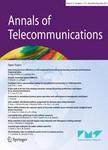版权所有:内蒙古大学图书馆 技术提供:维普资讯• 智图
内蒙古自治区呼和浩特市赛罕区大学西街235号 邮编: 010021

作者机构:ENST 46 rue Barrault 75634 Paris Cedex 13 Department of Electrical Engineering and Applied Science Case Western Reserve University case Institute of Technology 44106 Cleveland Ohio USA
出 版 物:《ANNALS OF TELECOMMUNICATIONS》 (电信纪事)
年 卷 期:1982年第37卷第1-2期
页 面:75-96页
核心收录:
学科分类:0810[工学-信息与通信工程] 0809[工学-电子科学与技术(可授工学、理学学位)] 08[工学]
主 题:Radio communication Binary transmission Noise Fading Diversity Redundant code Block code Linear code Decoding Probability theory Signal detection
摘 要:The conventional remedy to time and/or frequency variability of radio channels is diversity. Redundant coding is a kind of diversity, as each coded symbol can be recovered from other symbols. Only linear binary block codes are considered. Any binary random variable can be represented by its algebraic value,a real number whose sign indicates its most likely value and whose absolute value measures the probability of this value. The algebraic value of a received binary symbol is itself a random variable, whose distribution obeys a particular constraint. The algebraic value associated with the maximum likelihood decision on a binary symbol, given a set of independent received replicas of it, and that associated with the sum modulo 2 of binary random variables are also considered. The symbol-by-symbol decoding is then analysed in the case of threshold decoding, then in the general case. An approximate bound on the decoding error probability for additive Gaussian noise and coherent demodulation is used to assess the advantage of coding when unequalenergy symbols are received, according to a deterministic or a Rayleigh distribution. Simulation results are given for the Hamming (15,11) code. Coding affords a significant advantage provided the channel is good enough, while conventional diversity always provides gain.